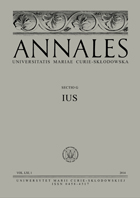Funkcje sztuki w twórczości naukowej Profesora Grzegorza Leopolda Seidlera
The Functions of Art in Sciefintic Works of Professor Grzegorz Leopold Seidler
Author(s): Anna Przyborowska-KlimczakSubject(s): Cultural history, Visual Arts, Aesthetics, Middle Ages
Published by: Wydawnictwo Naukowe Uniwersytetu Marii Curie-Sklodowskiej
Summary/Abstract: In his works, Professor G.L. Seidler emphasized the role of art as a catalyst for leading ideas of historical eras while those works were created. The ancient art reflected the idea of harmony, particularly evident in the sculptures of Phidias. In the Middle Ages the idea of hierarchy was the leading one. It was expressed in the great sacred works of Romanesque and Gothic art. Fixed in stone allegories of virtues and sins were also addressed to the faithful of this era. One of the most well-known sets are personifications of 18 virtues and 18 sins placed on two columns in Notbertine Church of the Holy Trinity and the Virgin Mary in Strzelno. The aim of the art of the Renaissance was the glorification of man and the world. The symbol of the Renaissance anthropocentrism is the statue of David, sculpted by Michelangelo. Professor G.L. Seidler has also devoted a lot of bis attention to the art of age of Enlightenment, which leading ideas were nature and reason. These ideas were expressed in Francisco Jose Goya's engravings. The pathos of the Jacobin revolution is apparent in the works of Jacques Louis David, and especially in three of bis paintings exhibited in the so-called "The Paris Salon" between 1785-1789.
Journal: Annales Universitatis Mariae Curie-Skłodowska, sectio G – Ius
- Issue Year: 61/2014
- Issue No: 1
- Page Range: 107-115
- Page Count: 9
- Language: Polish

